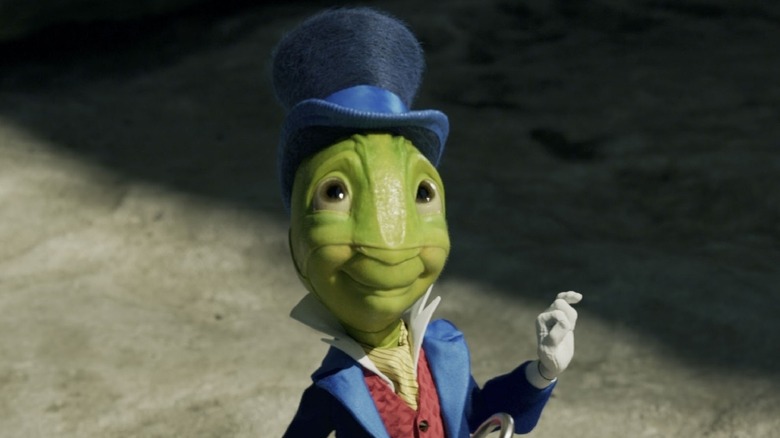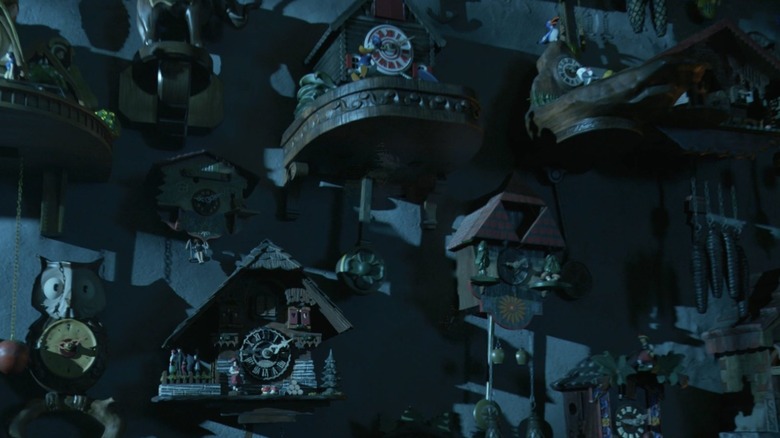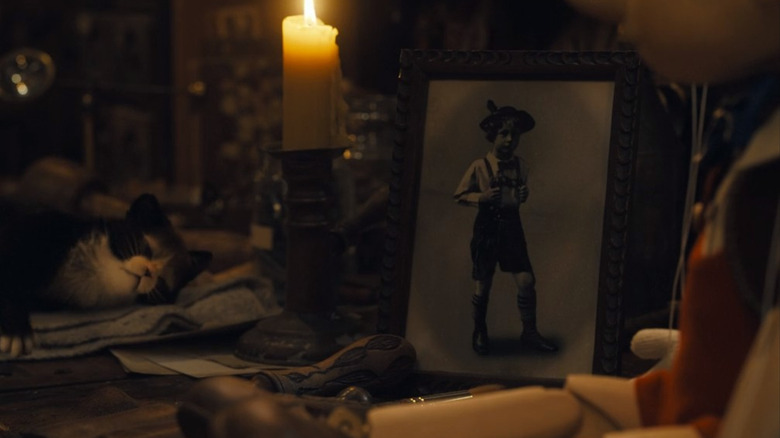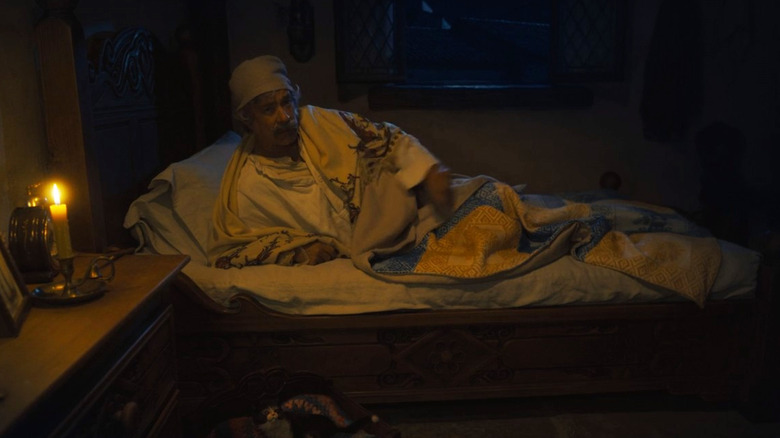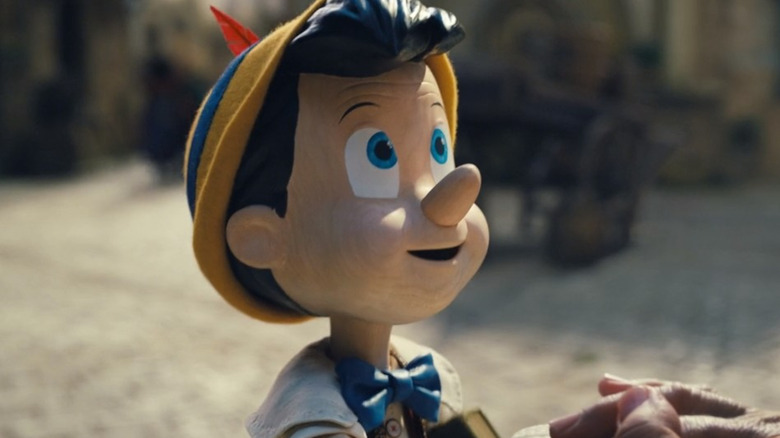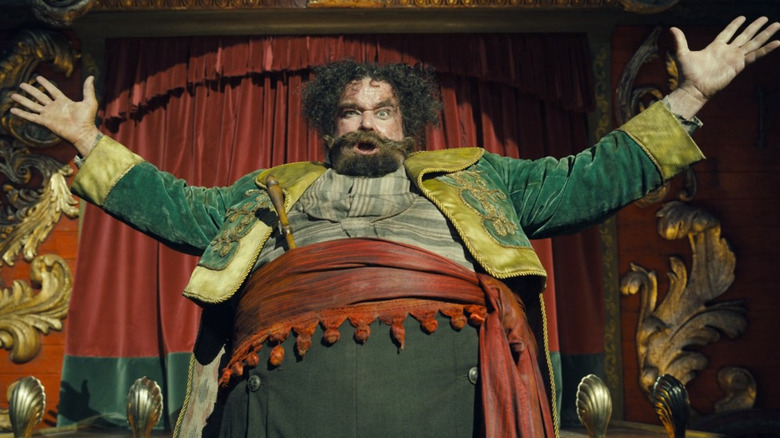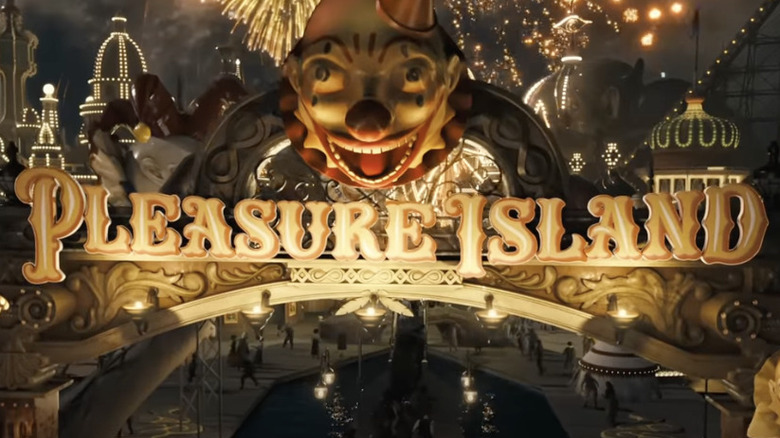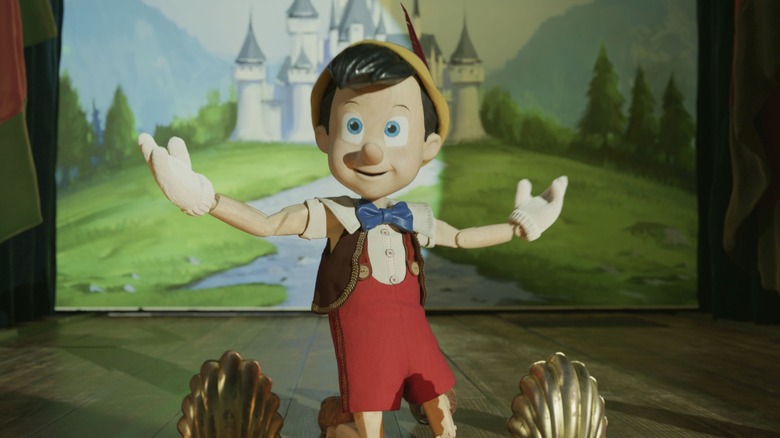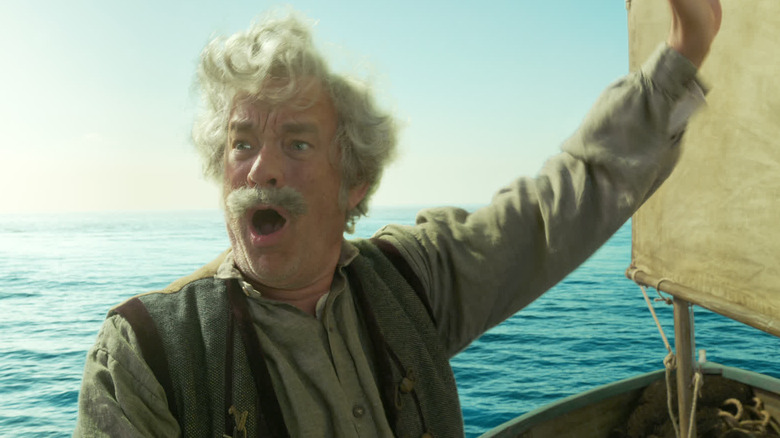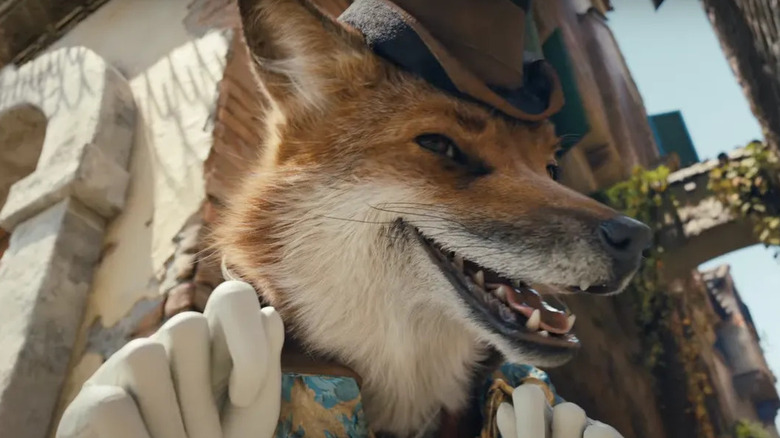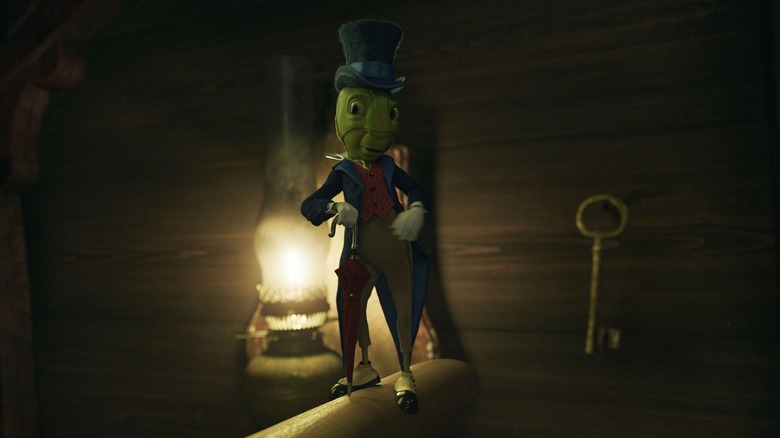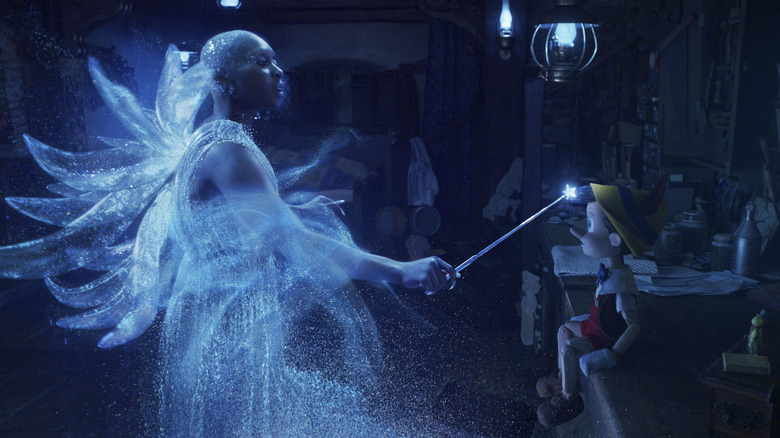Small Details You Missed In Pinocchio
"Pinocchio," Disney's 2022 live-action remake of the 1940 animated classic, makes it clear that the story of the little wooden boy with the ever-growing nose is still capable of delighting audiences of all ages. Geppetto (Tom Hanks), a lonely and heart-broken artisan, wishes to be a father so deeply, a fairy (Cynthia Erivo) is moved to magically grant life to a freshly-carved marionette. Thus, Pinocchio (Benjamin Evan Ainsworth) is born. Though he walks, talks, and plays like a little boy, he's still a creature of wood, whose nose grows every time he tells a lie. If he wants to become truly human, he must embark on a quest to prove his worth.
This iteration of "Pinocchio" is a fantastical and emotional fairy tale that explores human nature, familial bonds, and the scary things that lurk in the world's shadows. It's also packed with incredible visuals, ranging from electric landscapes built for fun and frolic to darkened streets full of menace and sharp edges. Jokes, references, and nods are omnipresent, poking fun at everything from Pinocchio himself to our own non-fictional world. In other words, a lot happens in "Pinocchio," to the point that it's easy to overlook much of what the film has to offer. We're here to help. From Jiminy Cricket's dark past to Geppetto's first son, these are the small details you might have missed in 2022's "Pinocchio."
Pinocchio meets Back to the Future
In Carlo Collodi's beloved 1883 novel "The Adventures of Pinocchio," Geppetto is depicted as a woodcarver of many specialties. He uses this multifaceted skill to create Pinocchio, a marionette with the appearance of a little boy. In Disney's 1940 adaptation of the tale, Geppetto is also shown to be a master clock builder. This trait is very much present in 2022's "Pinocchio." As in Disney's animated take on the story, this Geppetto builds utterly gorgeous cuckoo clocks featuring intricate carvings of people, animals, and natural landscapes.
Geppetto's association with timepieces brings to mind a very different movie that also happens to be directed by Robert Zemeckis: The 1985 sci-fi blockbuster "Back to the Future," which stands as one of his most popular and cherished films. That movie tells viewers it's going to be about the passage of time by starting off with a slow pan of the clocks that line the walls of mad scientist Emmett "Doc" Brown's workshop. Similarly, when "Pinocchio" moves into Geppetto's workshop, viewers see a massive wall of gorgeous clocks.
This isn't just a fun coincidence between two Zemeckis films — it's a potent symbol of the themes that distinguish them. In "Pinocchio," Geppetto is wildly obsessed with the constant loss of time. He believes his best days, which he spent with his true love, are tragically behind him. "Back to the Future" uses time travel to tell a similarly heartfelt story about the importance of days gone by.
Geppetto's first son
The basic plot of Pinocchio's story, from the original 1883 novel to its many cinematic adaptations, is well-known to viewers around the world and across time. Geppetto, a kindly Italian craftsman living a solitary life, builds a marionette resembling a little boy. The stories diverge on the details at this point: 1883's Pinocchio, for example, is indefatigably ill-behaved and carved from an apparently sentient block of wood. But the most well-known version of the tale to many modern viewers comes from Disney's 1940 adaption, in which Geppetto wishes for Pinocchio to become a living, breathing child. The Blue Fairy proceeds to bring the puppet to life, and tells him that if he can prove his virtue, he will be transformed into a real boy.
Few "Pinocchio" adaptations explore why Geppetto is so lonely, but the 2022 film is a fascinating exception. Viewers who look closely will notice that as a forlorn Geppetto puts the final touches on the Pinocchio marionette, an old photo of a human child sits beside him on his work table. It's heavily implied that this boy, captured in black-and-white, is Geppetto's real son, who seems to have died in childhood at some prior point. This isn't Geppetto's only loss: At another point he quietly and tearfully discusses his departed wife. The photo of the boy, with its mournful implications regarding Pinocchio's creation, is a subtle but devastating gut punch.
Geppetto exhibits symptoms of depression
The early moments of 2022's "Pinocchio" thoroughly hammer home the fact that Geppetto is a deeply sad person. This aging woodcarver is all alone in the world, and spends each day sitting in his workshop, talking to himself about his dead wife and his own loneliness. As evidenced by the slew of finished projects that fill the building, he pours himself into his work. The natural conclusion is that he does this to distract himself from his misery, and because there's nothing else for such an isolated person to do.
These details don't just suggest that Geppetto is unhappy — they create a clear and direct portrait of a man dealing with some form of depression. There are many other details that indicate this, as devastating as they are easy to overlook. For example, Geppetto refuses to sell any of his clocks to an eager customer who's willing to pay top dollar, because they serve as symbols and relics of the happy years he shared with his departed wife. Eventually, Geppetto angrily and pushily whisks the man right out of his shop, with the excuse that it's four minutes past six, and business hours are now over. Then, just a few moments later, Geppetto gets ready for bed. Oversleeping is a telltale sign of depression, according to the National Institute of Mental Health. A man who's in bed by 6:15 PM is in need of help.
How do you spell Pinocchio?
During his brief and highly frenetic appearance at the beginning of "Pinocchio," the nefarious Honest John (Keegan-Michael Key) delivers most of his lines in comically rapid-fire monologues. This befits his supposed reputation as a man of the theater. His words come so thick and fast, neither his sidekick, Gideon, nor his mark, Pinocchio, can get a word in edgewise. Even the most observant viewers will struggle to catch all the little jokes and jabs peppering his lines — but taking the time to notice them all is well worth it.
Two jokes about names stand above the rest. While discussing how the name Pinocchio won't work for the living puppet-turned-wannabe actor, Honest John attempts to spell the long and tricky moniker. He gives up halfway through and notes that a K is probably present. This reflects a very real fact that many children (and adults without a knack for spelling) have faced since 1883: Pinocchio is a uniquely difficult name to get right. Even if you know it doesn't have a K, you probably won't remember exactly how many times the letter C crops up, or exactly where. This justifies Honest John's suggestion that Pinocchio pick a stage name. He thinks "Chris Pine" is a great choice. This, obviously, is also a nod to real-world audiences, who know that Chris Pine is a real actor — one with a far more easily spelled name.
The accents are all over the place
Viewers who listen closely to the dialogue in "Pinocchio" will notice something unique: The accents of the characters don't really match the film's setting. In fact, they don't even really match each other. "Pinocchio" is set in an idealized Italian village at some point in time that roughly resembles the 19th century. Geppetto speaks in an Italian-accented mumble brimming with Tom Hanks' natural warmth. Pinocchio's would-be kidnapper Stromboli also speaks with an Italian accent. This makes sense, as he's played by Italian actor Giuseppe Battiston. But then there's Cynthia Erivo, who portrays the Blue Fairy with her natural London accent. She apparently bestows an American accent on Pinocchio, who is voiced by British actor Benjamin Evan Ainsworth. Complicating things even more is the street urchin Lampwick (Lewin Lloyd), who has a Bronx accent, and the Coachman (Luke Evans) he runs around with, who uses a Cockney brogue.
This is, to say the least, a bit of a linguistic jumble. Some viewers might find it confusing, or even outright baffling. One thing is clear: This mélange of accents makes "Pinocchio" a movie unstuck in place and time. But this isn't necessarily a flaw. Detaching "Pinocchio" from the specifics of history makes it more relatable to more people, and significantly more relevant to our modern world. It also allows a wide range of comic performers to vividly showcase their talents without the obstacle of a false accent.
Pleasure Island could be a Disney property
One of the major stops on Pinocchio's journey is Pleasure Island, which serves as a descent into humanity's wickedness. He must emerge from this trial with his goodness intact if he's to become a real boy. Finding himself on a coach full of kids on the way to this much-hyped paradise-meets-playground, Pinocchio initially sees Pleasure Island through naïve eyes — and so, in turn, do we. The scenes set in this fantastical place are among the most eye-popping and mind-boggling in the film: Pleasure Island is a lavish wonderland of color and music, where fireworks explode overhead and every building looks like an ornately decorated birthday cake.
This gorgeous imagery is to be expected: Disney knows a thing or two about making grand visions of amusement and spectacle into very real vacation destinations. In fact, Pleasure Island bears many similarities to iconic Disney theme parks. A huge Ferris wheel with a vivid face on the side will remind certain viewers of the Pixar Pal-A-Round Ferris wheel at Disney's California Adventure Park, which used to sport Mickey Mouse's gigantic face. This Paradise Island feature is set against an old-timey, small town-meets-boardwalk area, which is intensely reminiscent of the Main Street, U.S.A. portions of many Disney parks, distinguished by enticing shops and dessert parlors. Finally, elaborate fireworks and structures with tall, classical spires can be found in both Pleasure Island and real-world Disney parks.
Geppetto is a Disney fan
"Pinocchio" is a sweet-natured fairy tale set in a fantasy world full of talking foxes, magical crickets, and immensely powerful fairies. But it's still packed with numerous references to past Disney or Disney-adjacent projects from our world. There are so many, in fact, that it's incredibly easy for even the most devoted Disney fan to overlook most of them.
Early scenes set in Geppetto's workshop examine multiple shelves full of clocks, toys, music boxes, and sundry other creations the old woodcarver has poured his time and skill into. A closer look (aided by liberal use of the pause button) will reveal that Geppetto is a big Disney fan: He includes the studio's popular characters in a whole lot of his work. His cuckoo clocks feature Snow White from "Snow White and the Seven Dwarfs," Princess Aurora from "Sleeping Beauty," Disney icon Donald Duck, multiple animal characters from "The Lion King," and Roger and Jessica Rabbit from "Who Famed Roger Rabbit." Later on, when Pinocchio dances with another marionette in a ballet-themed show, the two frolic and leap in front of a painted backdrop depicting a castle. This imagined palace looks exactly like the one that greets visitors as they head into Disneyland.
Geppetto gets majorly ripped off
"Pinocchio" really gets going after the titular puppet sets out into the world — something that happens mostly against his will. Having just welcomed him to life a few hours earlier, Geppetto sends his brand-new son out of the house to go to school. But instead of getting a decent education, Pinocchio gets waylaid by scheming actors, a nefarious puppet show, a trip to Pleasure Island, and a transformation into a donkey, among other hardships, scrapes, and obstacles. When Pinocchio doesn't come home after his first day of school, Geppetto gets worried, and sets off to find him.
Sure, he's panicked and upset. But the old woodcarver's actions from this point on are lamentably foolish. In fact, it's implied that he gets massively ripped off in a genuinely tragic way. Viewers learn second-hand that Geppetto sells his vast collection of clocks to fund his Pinocchio recovery voyage. These are the precious possessions he refuses to sell at an earlier point in the movie, despite the fact that the prospective buyer offers big money for them. What does he rake in from the unseen second buyer? A beat-up old dinghy that barely floats and definitely won't withstand a major journey. When viewers connect the dots, they realize that Geppetto definitely got exploited in this deal, due to his haste. All those beautiful, handcrafted, one-of-a-kind clocks could have provided Geppetto with a small fortune, rather than a few bucks with which to buy an old boat.
Nearly every adult is bad news
There's no moral gray area in "Pinocchio": The good guys and the bad guys are clearly and distinctly delineated. The ones to root for are the people, fairies, and creatures who help and love young Pinocchio as he makes his way through a world he doesn't yet understand. The unabashedly evil characters are the ones who actively exploit and physically harm the hapless puppet. Strikingly, that latter category encompasses nearly every adult Pinocchio meets after he leaves home.
On his way to school, Pinocchio runs into Honest John, a sneaky and loathsome fox who will say whatever's necessary to make Pinocchio want to be an actor. He plans to sell the living marionette to a performance troupe, which essentially makes him a child trafficker. When Pinocchio finally gets to school, he's cruelly and violently thrown out. By this, we mean that the teacher literally throws him out of the classroom, tossing him into the air with such force and malicious intent that he lands a good 20 feet away. School, he is informed, is only for real children. Puppet show leader Stromboli similarly throws Pinocchio across a room and into a metal cage. And then there are the adults who run Pleasure Island, an exploitative child prison that transforms boys into donkeys, then sells them into service. Grown-ups in "Pinocchio" are almost universally cruel towards kids — especially the wooden ones.
The truth about Jiminy Cricket
Jiminy Cricket gets a character makeover in "Pinocchio." In Disney's 1940 take on the story, the cricket serves as a kindly narrator who explains the wild plot to the audience, and a largely hands-off advisor to the titular puppet. The 2022 film initially takes the same tack: Voiced by Joseph Gordon-Levitt, he floats into the story on the strains of "When You Wish Upon a Star," and addresses the audience directly. But then, the differences emerge.
While Jiminy Cricket is presented as a well-meaning and vaguely avuncular character deeply invested in Pinocchio's well-being in the 1940 film, 2022's Jiminy is appointed as the boy's official conscience by the Blue Fairy because he's, well, there. No reason is provided for why he's hanging around Geppetto's shop, because he doesn't seem to have a reason to be anywhere: This Jiminy Cricket is an itinerant wanderer who wears threadbare rags until the Blue Fairy magically grants him a fancier wardrobe to befit his new position.
With this act, "Pinocchio" implies Jiminy Cricket, an adorable symbol of magic and delight, experiences grinding poverty before he enters the story. The film also subtly implies that Jiminy Cricket is immortal. He narrates from the present day, indicated by the modern references he makes, and is framed as specifically recounting his own memories. This means he's a 200-year-old insect.
Pinocchio is, essentially, about itself
Disney's ongoing project to remake its most enduring animated films as live-action movies is necessarily self-referential. That's a big part of why people watch them: Seeing famous sequences once rendered in pen and ink writ large through flesh-and-blood actors and hyper-realistic computer animation is a unique (and usually entertaining) experience. But entries in this sub-genre, including 2015's "Cinderella," 2019's "Dumbo," 2019's "Aladdin," and 2017's "Beauty and the Beast" are also deliberately self-aware and even outright meta — none more so than 2022's"Pinocchio."
"Pinocchio" is, essentially, a story about itself, and Disney's wider repurposing of its library of content. Pinocchio is a toy imbued with a reasonable facsimile of life, who wishes desperately to become an actual human child. 2022's "Pinocchio" is an attempt by a mammoth movie studio to turn a cartoon, which is itself an imitation of life, into something more corporeal. In other words, "Pinocchio," as a live-action remake, strives to bring an imaginary story into the real world. This adds a very clever level of philosophy to the movie sharp-eyed viewers are sure to enjoy.
